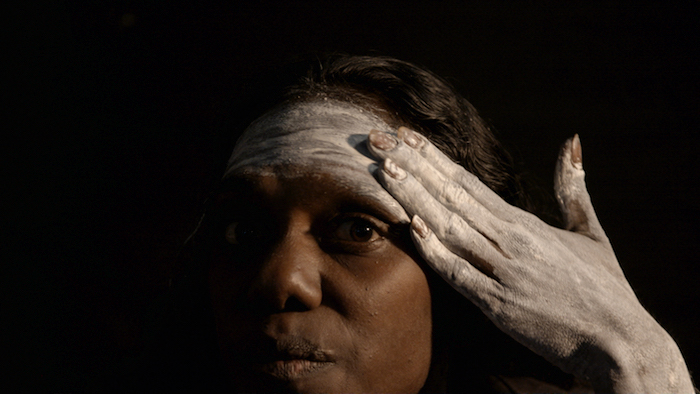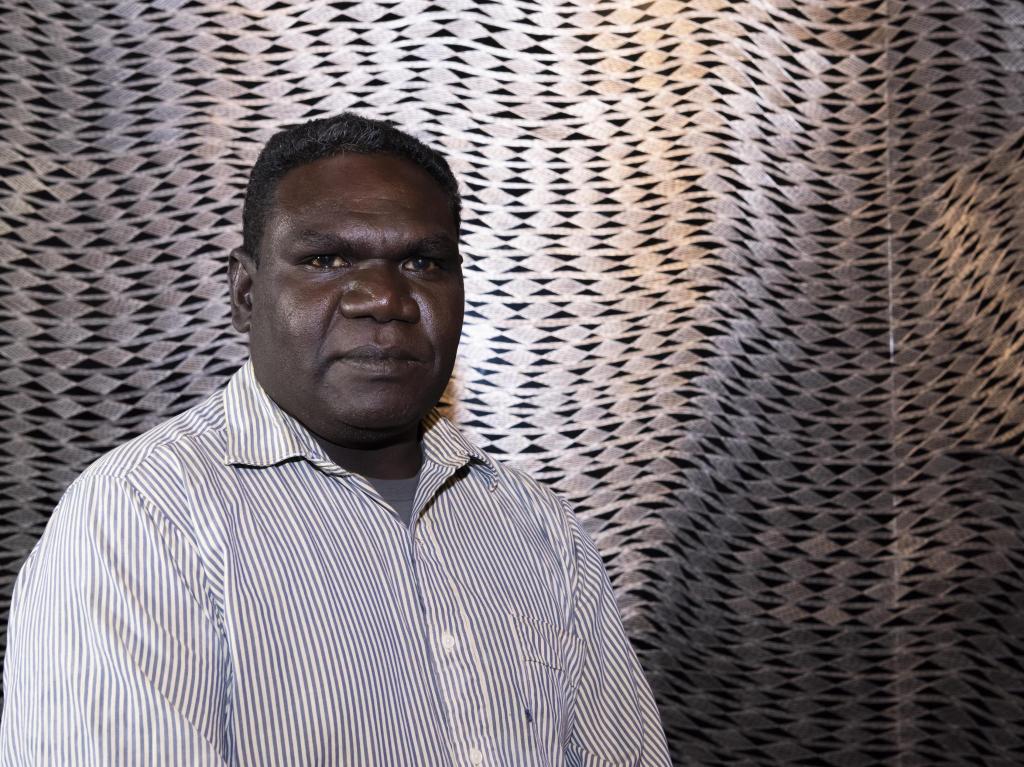Gunybi Ganambarr in front of his winning work Buyku (2018), 2018 NATSIAA at Museum and Art Gallery of Northern Territory; MAGNT photographer, Merinda Campbell
Over the weekend, the 2018 Telstra National Aboriginal and Torres Strait Islander Art Awards (NATSIAA) were announced, building upon a 35-year legacy of celebrating the diversity of our First Nations artists.
It was staged in Darwin by the Museum and Art Gallery of Northern Territory (MAGNT), and gallery Director, Marcus Schutenko said the quality of the art works in this year’s awards were the strongest he had seen.
This year the $50,000 Telstra Art Award has gone to a work that is being described as ‘unconventional’, an intricately etched three-by-three metre aluminium board by Gan Gan artist, Gunybi Ganambarr who comes from the remote community of Gan Gan in East Arnhem Land in the Northern Territory.
It was selected from more than 300 entries and 66 finalists.
‘Every year we are inundated with these incredible entries; it remains the prize that artists want to win, the prize they want to be part of,’ said Luke Scholes, MAGNT’s Curator of Aboriginal Art.
Scholes said the Awards are important because they give Aboriginal and Torres Strait Island artists a platform that they perhaps don’t get elsewhere.
‘We are driven not just by legacy. The Awards bring what our Aboriginal and Torres Strait Island artists are doing into the national conversation. I think there are certainly messages in this year’s Awards, but they aren’t that kind of confrontational work we have seen in previous years,’ he said.
‘The opportunity to walk around this eclectic exhibition, and to switch off, tune in and listen to these incredible artists, is an amazing moment to engage with something bigger than ourselves. It is not just about preaching to the converted,’ added Scholes.
Schutenko continued, ’The layout of the gallery has been designed in a completely new way to complement the diversity of forms in the exhibition. I expect audiences will feel a significant sense of discovery when they come to the 35th Telstra NATSIAA.’
Telstra NATSIAA finalists’ works will be exhibited at the Museum and Art Gallery of the Northern Territory in Darwin until Sunday 11 November 2018.
Industrial materials bridge contemporary and traditional conversations
Gunybi Ganambarr’s winning work, Buyku, speaks of the coming together of the Dhalwangu clan for fish trap ceremonies, and how these ceremonies unite Yolŋgu.
The work honours Ganambarr’s forebearers, specifically his mari or grandfathers, who are represented through a weave of etched forms depicting water and fish traps. Gunybi is famous for having extended the definition of what can be used in the creation of sacred art.
Scholes told ArtsHub that this year there was a particularly strong representation of artists from North East Arnhem Land.
‘It has been a long time coming – this kind of result was inevitable when you have such a powerful group of artists. That is the nature of the Yolngu – they have this interest in regeneration and the outside world and where they might fit in, and yet they totally adhere to Yolngu law. I am over the moon with the judges’ decisions; they are brave decisions, and you can not dispute them,’ said Scholes.
The judges said Ganambarr’s command of materials and processes have resulted in a work that actively engages the viewer physically, intellectually and emotionally.
Scholes continued: ‘It is funny with Gunybi, he refuses to be categorised. The trouble with categories is that over the years artists want to challenge those conventions. It is so refreshing when artists like Gunybi have this burning vision, and it is our job to put in in this exhibition and make sense of it.
‘He is just one of these guys who can’t sit still. He takes things from the environment and makes work from it, whether it’s materials from the mining industry or a tree on his drive home. If you think back to early Papunya paintings, that is exactly what those old fellas were doing – to find something from their environment and use it to tell a story.’
The NATSIAA is more than one winner
The Telstra NATSIAA are comprised of six categories across multiple art disciplines and a diverse range of entries. Scholes said, ‘Our multi-media category has taken a big leap forward. Last year there were just three entries, this year there were seventeen, several of them with sculptural works that go with the videos.
‘The pure video work by Patrina Liyadurrkitj Mununggurr is a deeply felt homage to the white pigment used in ceremony. It is just beautiful. That is the other part of the phenomenon of NATSIAA – every year these artists just announce themselves and pop out of the woodwork and it reminds us how culture is being perpetuated. We need these curve balls,’ he said.

2018 NATSIAA Multimedia winner, Patrina Liyadurrkitj Mununggurr with Dhunupa‘k um nhuna wanda (Straightening your mind); supplied courtesy the artist
The 2018 NATSIAA category winners are:
Telstra General Painting Award: Peter Mungkuri, Indulkana, SA / Ngura (Country)
Mungkuri’s paintings are loaded with an energy and movement, and quietly shimmer with romanticism and a reverence for country.
Telstra Workson Paper Award: Kathy Inkamala, Mparntwe (Alice Springs), NT
Following in the path of her great-uncle Albert Namatjira, Kathy Ngala Inkamala began painting in the Hermannsburg School Watercolour tradition in 2015. Her winning painting Mount Gillen, Western MacDonnell Ranges is characterised by a tightly illustrative approach to mark-making, repetitive line work and a highly saturated use of colour.
Telstra Bark Painting Award: Napuwarri Marawili, Yilpara, NT
Napuwarri learnt his skill from his father, the artist Bakulaŋay Marawili. Using a versatile range of artistic skills, his winning work is an evocative piece representing an ancestral journey, in which a hunting party took to the sea in pursuit of Dugong.
Wandjuk Marika Memorial 3D Award (sponsored by Telstra): Wukun Wanambi, Yirrkala, NT
Wukun is a previous NATSIAA Award winner, having been awarded the 1998 Bark Painting award and a Highly Commended in the 3D category in 2003. His 2018 winning entry Destiny evokes the turbulent waters of Gurkawuy River clashing with the incoming tidal waters near Trial Bay. He says: ‘The water is called Gudutja and they are looking for their destiny, just like you and I tracing our family tree on a computer, looking for our great, great grandfathers and grandmothers.’
Telstra Multimedia Award: Patrina Liyadurrkitj Mununggurr, Yirrkala, NT
Titled, Dhunupa‘k um nhuna wanda (Straightening your mind), this film shows the artist painting her forehead with gapan (white clay), which Yolŋgu use on their face and body for ceremonial purposes.
Telstra Emerging Artist Award: Matthew Dhamuliya Gurruwiwi, Warruwi, NT
Banumbirr, or Morning Star Poles, are ceremonial poles belonging to the Galpu clan of Arnhem Land. Made using soft local wood, natural earth pigments, feathers, bush wax and handmade bush string, they are traditionally used for funeral ceremonies.
All category winners receive $5,000. The winning works were selected by a judging panel comprised of Kelly Gellatly, Director of the Ian Potter Museum of Art at the University of Melbourne; Glenn Iseger-Pilkington, independent curator and art consultant, and Judith Inkamala, artist and senior member of the Hermannsburg Potters.
Telstra NATSIAA finalists’ works will be exhibited at the Museum and Art Gallery of the Northern Territory in Darwin until Sunday 11 November 2018.
For full details go to www.magnt.net.au
@MAG_NT #magnt #natsiaa #telstranatsiaa





